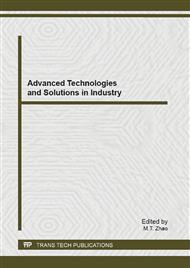p.102
p.106
p.112
p.117
p.122
p.127
p.132
p.136
p.142
Characterizing Woodiness Carbon Fiber Precursor by Fractal Geometry Approach in Different Curing Conditions
Abstract:
For exploring the variation of the surface morphology of carbon fiber precursor which was obtained from different curing conditions,this paper used the fractal dimension measurement method to analyze morphological characters of carbon fiber precursor surface through the electronic scanning electron microscopy image recognition and computer fractal calculation system. The experimental results show:the surface fractal dimensions of carbon fiber precursor were between 2.480~2.622 by TPSAM method, and the surface fractal dimensions of carbon fiber precursor were between 2.555~2.633 by PCM method, both methods show that the carbon fiber precursor surface is smooth. And the CCM is 2.678~2.755, this method shows that the precursor surface is concave and convex. The fractal dimension value obtained by TPSAM method and PCM method is closer, while the CCM is different. But the trend is almost the same, which shows that using the fractal dimension method to desirable the surface structure of carbon fiber precursor is desirable.
Info:
Periodical:
Pages:
122-126
Citation:
Online since:
June 2013
Authors:
Keywords:
Price:
Сopyright:
© 2013 Trans Tech Publications Ltd. All Rights Reserved
Share:
Citation:


